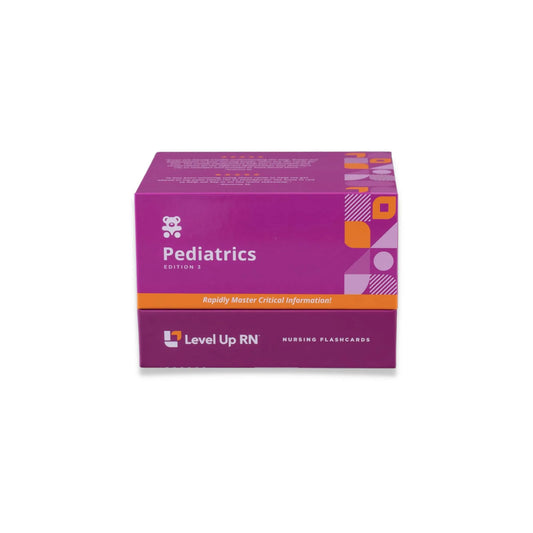When you see this Cool Chicken, that indicates one of Cathy's silly mnemonics to help you remember. The Cool Chicken hints in these articles are just a taste of what's available across our Level Up RN Flashcards for nursing students!
In this article and video, we cover pediatric congenital heart defects that increase pulmonary blood flow, as well as those that decrease pulmonary blood flow.
This series follows along with our Pediatric Nursing - Flashcards which are intended to help RN and PN nursing students study for nursing school exams, including the ATI, HESI, and NCLEX.
Congenital heart defects leading to increased pulmonary blood flow
Congenital heart defects that increase pulmonary blood flow include the atrial septal defect, a ventricular septal defect, an atrioventricular canal defect, and a patent ductus arteriosus.
Atrial septal defect
An atrial septal defect (ASD) is a congenital heart defect where a hole in the septum separates the left and right atria of the heart. An ASD leads to increased pulmonary blood flow.
Patients with this type of defect may be asymptomatic, but it can also cause signs and symptoms of heart failure as well as a murmur.
This murmur will be a systolic murmur with a wide, fixed splitting of S2.
Treatment options for ASD include closure with cardiac catheterization and surgical patch closure.
Ventricular septal defect
A ventricular septal defect (VSD) is a congenital heart defect where there is a hole in the septum that separates the left and right ventricles of the heart. So it's the same concept as ASD described above, but the hole is between the ventricles rather than the atria. VSD leads to increased pulmonary blood flow.
Signs and symptoms of VSD include signs and symptoms of heart failure as well as a murmur. This murmur can be described as a loud systolic murmur at the left sternal border.
Treatment options for VSD include surgery to suture or patch the hole.
Atrioventricular canal
An atrioventricular canal (AV canal) defect is a congenital heart defect where there is a large hole in the center of the heart that allows blood to flow between all four chambers of the heart. Instead of a mitral valve and a tricuspid valve, patients with an AV canal defect have a single AV valve. An AV canal defect leads to increased pulmonary blood flow.
An AV canal defect can cause signs and symptoms of heart failure as well as a loud systolic murmur.
Treatment options for an AV canal defect include surgical patch closure, as well as valve reconstruction.
Patent ductus arteriosus
A patent ductus arteriosus (PDA) defect is a congenital heart defect where the fetal artery that connects the aorta to the pulmonary artery fails to close after birth. A PDA defect can cause signs and symptoms like a machine hum murmur, bounding pulses, and a wide pulse pressure (a large difference between the systolic blood pressure and the diastolic blood pressure). PDA leads to increased pulmonary blood flow.
Treatment for a PDA defect can include the use of indomethacin, which is an NSAID, and using coils to occlude the PDA during cardiac catheterization. Indomethacin and other cardiac meds are covered in detail in our Pharmacology - Nursing Flashcards
A story from Cathy on how to remember PDA symptoms and treatment
Another little story that may be helpful for you to remember some of the signs and symptoms of this congenital heart defect, if you look at PDA, that also stands for public displays of affection. So I imagine a dad looking out his window and seeing his daughter engaging in PDA with a boy he really doesn't like, and that causes him to have bounding pulses. And he wished he had a machine gun, which he doesn't have, and he opens up the window and he yells, "Get in here." So this little story will help you remember, with PDA, that it will cause bounding pulses, a machine hum murmur, and that Indomethacin is used to treat it. When he yells, "Get in here," that will help you to remember Indomethacin. So hopefully, that little story helps.
Congenital heart defects leading to decreased pulmonary blood flow
Congenital heart defects that lead to decreased pulmonary blood flow include tetralogy of Fallot, and tricuspid atresia.
Tetralogy of Fallot
Tetralogy of Fallot (TOF) is a congenital heart defect comprising four different defects: pulmonary stenosis, right ventricular hypertrophy, overriding aorta, and ventricular septal defect. Tetralogy of Fallot causes decreased pulmonary blood flow. You can remember that it's made up of four defects by knowing that the tetra- prefix means four.
 PROVE that you know all 4!: Pulmonary Stenosis, Right Ventricular Hypertrophy, Overriding Aorta, Ventricular Septal Defect, Excellent you got all four!
PROVE that you know all 4!: Pulmonary Stenosis, Right Ventricular Hypertrophy, Overriding Aorta, Ventricular Septal Defect, Excellent you got all four!
Signs and symptoms of TOF include cyanosis (the child may have hypercyanotic or "tet" spells). To address cyanosis, you should place the patient in a knee-chest position in order to increase blood flow to the lungs. In addition, the patient may have a systolic murmur present.
Treatment for TOF includes surgical repair within the first year of life.
Tricuspid atresia
Tricuspid atresia is a congenital heart defect where the tricuspid valve, which normally separates the right atrium from the right ventricle, fails to develop, and blood flows through a ventricular septal defect or an atrial septal defect. Tricuspid atresia causes decreased pulmonary blood flow.
Signs and symptoms of tricuspid atresia include cyanosis, tachycardia, dyspnea, as well as clubbing (upside-down, spoon-shaped nails) indicative of hypoxia.
Treatment of tricuspid atresia can require multiple surgeries, including shunt placement, a Glenn procedure, and a Fontan procedure.


